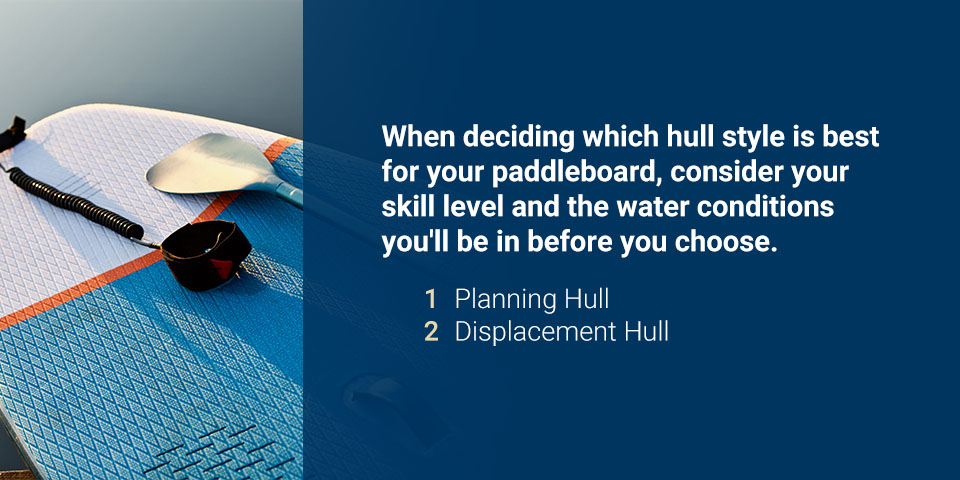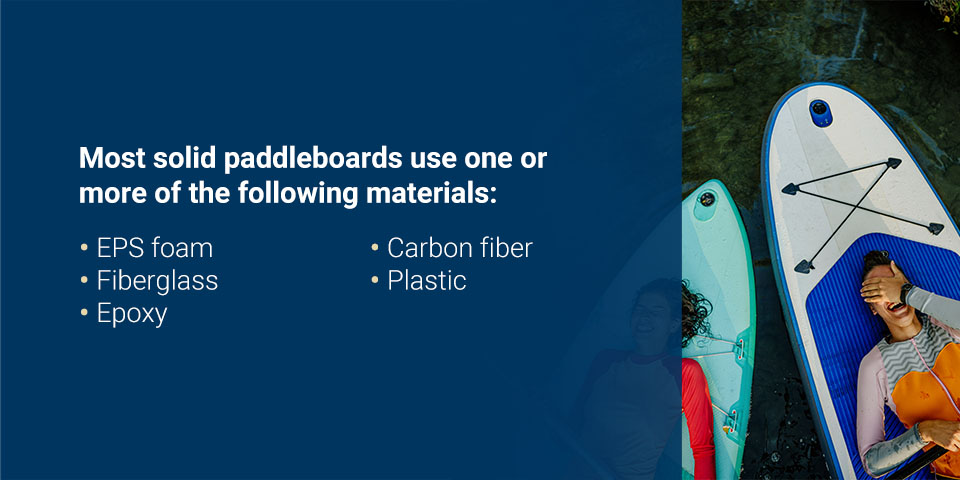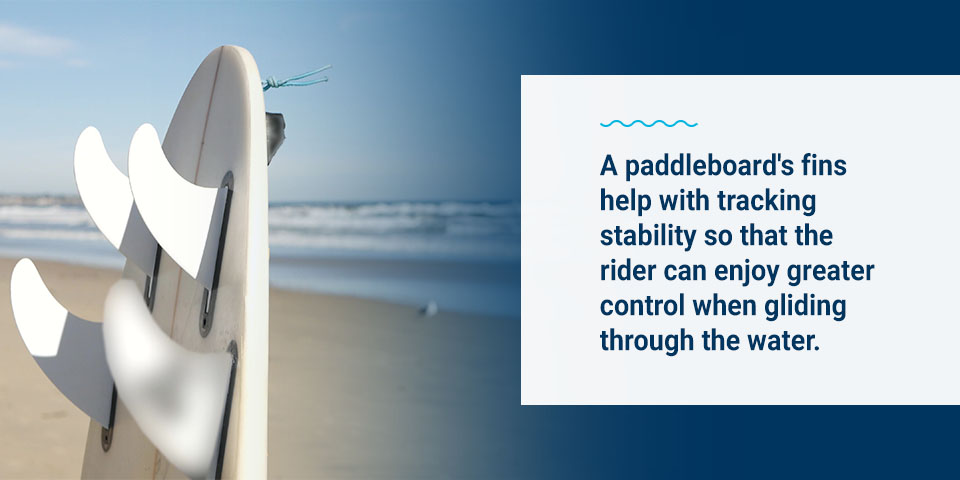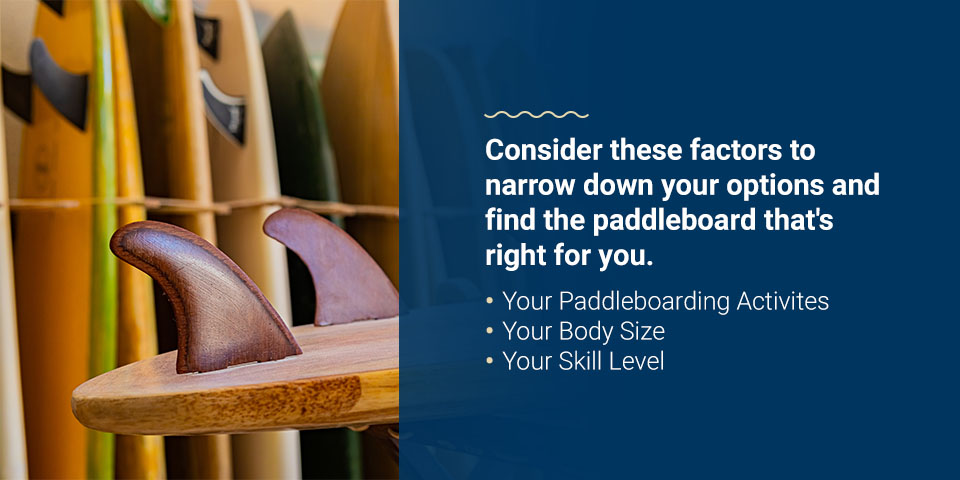Filters
Paddleboard Buying Guide
Paddleboarding is a fun, low-impact watersport that is great for exploring new waterways and spending time outdoors. People of all ages can hop on a board and enjoy various paddleboard activities.
If you’re interested in buying a new board, there are several factors to keep in mind. It’s best to consider everything from its dimensions to how you plan to use it to be sure you’ll choose the paddleboard style and configuration that meets your needs.
Learn more about how to pick the right paddleboard for you with this stand-on board and paddle buying guide.
What Is Paddleboarding?
Stand-up paddleboarding (SUP) is a watersport that grows in popularity every year. Participants use long paddles and wide, long boards to ride the water’s surface while standing or sitting.
SUP requires balance and low-impact movements, making it a beginner-friendly sport that the whole family can enjoy. You can use paddleboards for many outdoor activities, such as:
- Fishing and crabbing
- Yoga and exercise
- SUP surfing
- Touring
- Relaxing
- Snorkeling and diving
- Racing
There are a lot of considerations to make before buying a paddleboard. Different styles and features will impact how you maneuver through the water and what activities you can undertake.
Types of Paddleboards
Different types of paddleboards have features suited for different activities. Before buying a new board, consider what style will be best for the way you want to use it. The seven main types of paddleboards to choose from are:
- All-around: This type of board is perfect for beginners. Its rounded nose and wide body are good for stability. If you want to participate in a wide range of activities, all-around boards are likely your best option.
- Fishing: Fishing boards are often larger, with more surface area than other board types. The extra area makes it easier to balance and gives you additional space for your gear.
- Racing: This type of board is long and narrow to optimize speed. It’s best suited for experienced riders — staying stable is often more challenging than other styles.
- Surfing: A surfing paddleboard looks like a thicker, wider surfboard. While its shape makes it useful for riding waves and maneuvering through the water, it can be more challenging for riders to control. This board is a better choice for skilled paddlers.
- Touring: You can experience the best glide through the water with a touring board. These have a long yet stable design suited for traveling long distances on the water.
- Whitewater: Whitewater boards are easy to control and always inflatable. Their design is short and wide to help riders move flexibly and avoid rocks.
- Yoga: If you plan on paddleboarding on calm bodies of water, a yoga board might be your best option. With their long decks, this type of board gives riders the room they need for stretching and putting their balance to the test.
The Type of Hull
A paddleboard’s hull, or body, is responsible for how it interacts with the water. Most boards have either planing or displacement hulls. When deciding which hull style is best for your paddleboard, consider your skill level and the water conditions you’ll be in before you choose.
Planing Hull
A paddleboard with a planing hull has a shape similar to a surfboard, flat and wide with a rounded nose. Planing hulls are good for leisurely activities that don’t require quick movements.
Boards with a planing hull are round and ride on top of the water rather than slicing through it. They’re easy to maneuver and offer additional stability for riders who want to participate in controlled movement activities like SUP yoga or leisure paddling. They’re also a great option for people who want more support and steadiness on rougher waterways.
Displacement Hull
A displacement hull has a pointed nose to cut through the water and maximize speed. Boards with this type of hull more closely resemble a kayak than a surfboard.
While this design makes the board more difficult to maneuver, it also slices through the water efficiently, making it easier for paddlers to travel long distances. Boards with this hull are best for activities like touring or racing.
Solid vs. Inflatable
It’s important to consider whether you want a solid or inflatable board. Both options have pros and cons — it’s important to consider both when deciding between the two.
Solid Boards
Most solid paddleboards use one or more of the following materials:
- EPS foam
- Fiberglass
- Epoxy
- Carbon fiber
- Plastic
Solid boards are the best option for performance and competitive activities. These boards allow riders to travel faster and offer more stability on the water, as they tend to ride lower.
However, solid paddleboards also require more room. Before buying a solid paddleboard, consider how much space you have for storage and transportation.
Inflatable Boards
Inflatable paddleboards have a PVC exterior and an air core that you inflate with an air pump. When it’s time to put your board away, you can simply deflate it and keep it in a storage bag, making inflatable options ideal for buyers with limited storage space. You can keep your board in the back of your car or in a closet—no need for a garage or rack.
While these boards inflate like a plastic raft, they should feel rigid and firm rather than squishy when fully inflated. Inflatable boards are best for yoga and whitewater activities.
Volume and Weight Capacity
When shopping for a new paddleboard, it’s important to figure out the right volume and weight capacity for your size. When you ride a paddleboard, it displaces the water to support your body and offer stability. Using a board with the wrong volume and weight capacity can make riding more challenging, changing how the board performs on the water and its stability.
The volume of a paddleboard is measured in liters and indicates the amount of weight the board can support. The higher the volume, the more weight the board can sustain. Manufacturers measure a board’s weight capacity in pounds, though some may also include the weight in kilograms.
It’s important to note that your body weight and any gear you bring with you on your board will impact how it floats. If you and your equipment exceed a paddleboard’s practical weight limit, the board will ride lower, making it more challenging to paddle and maneuver through the water.
Before picking out a new paddleboard, consider the hull type as it relates to volume and weight capacity. Most planing hull boards will perform well as long as you’re below their weight capacity. Displacement hull boards are less forgiving, however. Too much weight will cause the board to sink too low in the water, while too little weight will make the board feel heavier and harder to steer.
A board’s length, width and thickness determine its volume and weight capacity and are just as important to consider.
Length
A paddleboard’s length is a huge determining factor for how it will move in the water. As a general rule, longer boards are better for speed and shorter options are best for maneuverability. When buying a new board, knowing how you plan to use it will help you choose the right length.
Shorter boards are typically under 10 feet long. Smaller boards move better through the water and respond to the rider better than longer options. Beginners should start with a board between 9 and 11 feet, which will be easier to handle.
Medium boards range from around 9 to 12 feet long. Many medium-sized options have a planing hull and offer a great balance between speed and maneuverability.
Boards longer than 12 feet are best for activities that require moving quickly and in one direction, like racing or touring. While long paddleboards are often faster than shorter ones, they’re also more challenging to control and handle.
Additionally, the longer the board is, the higher its volume and weight capacity tend to be, making it feel more stable for the rider.
Width
Width is another crucial factor to consider when choosing a paddleboard. If you plan on participating in activities that require speed, thinner boards are best. For people who want a slower and more stable experience while riding, wider options are a better choice.
Before purchasing a new board, consider how width impacts the following:
- Storage: How much gear you need to bring with you will depend on what activities you plan to partake in. Be sure to choose a board that can support your gear and has the extra space to store it.
- Body type: When finding the right width for your paddleboard, you must assess your own body type. Be careful to pick an option that works well with your weight and height while offering enough room for movement. If you’re doing an activity like paddleboard yoga, it’s important to choose a board that gives you adequate space to hold poses.
- Paddling: In addition to your body type, make sure to pick a board with a width conducive to paddling.
- Skill level: Most beginners work best with boards that are more stable and have a wider width. Experienced riders often opt for narrower boards.
Thickness
A board’s thickness directly relates to its weight capacity. Two boards with the same length and width but different thicknesses will support different amounts of weight. All other measurements being equal, a thicker board will have a greater volume and support more weight than a thinner one.
Handling a thick board is typically more challenging for riders. While they give the rider more stability, they also offer less maneuverability. Thicker paddleboards are better for activities like yoga or fishing than activities requiring speed and agility.
Fins
A paddleboard’s fins help with tracking stability so that the rider can enjoy greater control when gliding through the water.
As a general rule of thumb, larger fins provide more steadiness for paddlers. Smaller fins typically offer the rider more movement and are best for activities requiring quick pivots and direction changes. Fins with wide bases and long front edges will help a board move in a straighter path and stay more stable while traveling.
Most fins are removable, letting you swap them out depending on what activity you plan on participating in. When it’s time to store your paddleboard, you can remove the fins to help it take up less room and fit in tighter spaces.
Boards often have one of three fin configurations:
- Single fin: Many stand-up paddleboards use one fin attached to the board using a nut and screw. Single fins are good for tracking and reducing drag.
- 3-fin: Also called a thruster, this setup uses three fins of the same size. The 3-fin setup helps boards cut through the water in a straighter path and offers greater control for riders.
- 2 and 1: While this setup also uses three fins, the fin in the center of the fin box is larger than the fins on either side.
Inflatable paddleboards also usually use one of these configurations, although their fins are typically made from flexible rubber.
Paddles
Paddles are a vital tool for most SUP paddleboarding activities. The best options are lightweight and easy to move, and adjustable options let you choose the right height and configuration for you while still being able to share them with friends and family.
Most paddles are made of one of the following materials:
- Aluminum
- Carbon fiber
- Fiberglass
- Plastic
Size
Blade size is an important factor for SUP paddles and will change how the paddler feels when making strokes in the water.
Because larger blades move more water with one motion, bigger paddles give you more power but often require more strength. While smaller paddles move less water per stroke, they’re usually easier to work with than larger options.
Shape
Blade shape will determine how water flows around your paddle.
Teardrop-shaped blades have more surface area at the bottom of the paddle. This design can pull more water with every stroke, making it more powerful and efficient.
Rectangular-shaped blades are more narrow at the bottom of the paddle, allowing gentler strokes that are easier to pull through the water.
Offset
Blade offset refers to the bend in the blade. Most paddles have a slight offset that makes it easier to power through the water and helps keep the board tracking straight. The angle of the blade offers more efficiency and allows you to travel further using less energy.
Accessories and Extras
Once you’ve found the perfect paddleboard and paddles, it is time to think about the extra pieces of equipment you’ll need to make the most of your new board.
Some of the important accessories that make paddleboarding activities easier and safer include:
- Attachment mounts: Many boards have attachment points for accessories like cameras or fishing rods. You can buy the accessories and attachment mounts separately.
- Carrying handle: A carrying handle is especially important for large boards that are challenging to transport. You can find different adjustable carrying handles that work with many board sizes.
- Leash: If you want to tether your board to your leg, you’ll need to find a leash. These help keep you and your board together, especially in unsettled water.
- Personal floatation device: Every paddleboarder should have a life vest or other floatation device for emergency situations.
- Roof rack: If you plan to transport your paddleboard with your car, getting a roof rack can help make it easy while protecting and securing your board.
- Straps and tie-downs: Bungee straps and tie-down spots are a great way to secure your board and accessories to your vehicle.
Costs
While paddleboards have many features that contribute to their overall cost, the categories with the most impact on the price of a paddleboard include:
- Size: The size of a board will change the price tag. Typically, larger boards are more expensive, and smaller boards tend to be more affordable.
- Quality: The materials used for a paddleboard will influence its costs. Solid boards made of epoxy are often the priciest option, while foam and inflatable choices are usually cheaper.
- Construction: A board’s construction often determines its durability and performance. The tougher and more resistant a board is, the more it’s likely to cost.
- Extra accessories: From paddles to leashes, the accessories you choose to pair with your paddleboard can add up and contribute to your overall costs.
What Type of Paddleboard Should I Buy?
Now that you know the details, you’re ready to find your perfect board. Consider these factors to narrow down your options and find the paddleboard that’s right for you.
Your Paddleboarding Activities
It’s essential to consider what activities you want to do with your paddleboard. Knowing how you want to use it will help you choose the best type of board.
If you want to participate in fast-moving water sports, you’ll probably want a solid board rather than an inflatable option. Longer boards are better for speed, while shorter boards are best for maneuverability.
Likewise, board thickness will impact how your board moves through the water — it can be helpful to consider if you want a thicker board for more stability or a thinner board for more movement.
Wider boards often add stability as well and are best for activities like crabbing or relaxing, while narrow options are better for sports like surfing and racing.
If you plan to partake in activities that require a fast pace, you’ll also want to opt for a displacement hull that cuts through the water rather than a rounder planing hull.
Your Body Size
Part of picking a paddleboard is considering your body measurements and composition. You’ll want to find a board with the volume and weight capacity to support you properly.
You’ll also need to factor in your height when choosing paddles. Adjustable options will help you find the perfect fit for your body. If you decide to buy a fixed paddle, make sure it is about 8 to 10 inches taller than your height.
Your Skill Level
Your level of experience will influence the type of paddleboard you should choose. Be sure to select a board that offers you the right amount of stability for your skills.
Pick your paddleboard’s fins based on what activities you want to participate in and how much control over your board you want to have. Larger fins are better for stability, while smaller options are more maneuverable.
Your skill level will also impact what kind of paddles you should use. If you’re a beginner, you may want to start out with a rectangular-shaped blade with a small offset to make your strokes easier.
Choose the Best Paddleboard for You
Once you’ve found the perfect board for you, it’s time to get out on the water. Consider enhancing your experience with a floating paddleboard dock by EZ Dock to make getting in and out of the water easier.
Our docks are perfect for lake and ocean paddleboarding. Our easy launch systems make it easy to get to your feet and out on the water quickly. Whether you need slip resistance or a custom design, we’ve got the options for your unique needs.
Are you interested in learning more about our versatile paddleboard docks? Contact EZ Dock or request a quote online today!



















